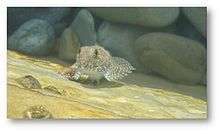Clinocottus analis
| Clinocottus analis | |
|---|---|
 | |
| Scientific classification | |
| Kingdom: | Animalia |
| Phylum: | Chordata |
| Class: | Actinopterygii |
| Order: | Scorpaeniformes |
| Family: | Cottidae |
| Genus: | Clinocottus |
| Species: | C. analis |
| Binomial name | |
| Clinocottus analis (Girard, 1858) | |
Clinocottus analis is a species of fish in the family Cottidae, one of the families of sculpins. It is known commonly as the woolly sculpin in English and the charrasco lanudo in Spanish.[1] It is native to the eastern Pacific Ocean, where it occurs along the coastline of California and Baja California.[1]
This fish reaches up to 18 centimeters in length.[1]
This species lives on the seabed of intertidal waters up to 18 meters deep.[1] It is commonly found in tide pools amidst algaes, but it leaves the tide pool area at will.[1] It can breathe air and has been known to survive out of water for up to 24 hours.[2]
The diet of this species includes mainly crustaceans, especially amphipods, as well as fish eggs and larvae, polychaetes, and molluscs. Most of its food items are light-colored or clear, suggesting that these are easiest for the fish to see against the dark background of its habitat.[3]
This fish has green blood plasma, the color caused by biliverdin tightly bound in protein complexes.[4]
References
- 1 2 3 4 5 Froese, R. and D. Pauly, Eds. Clinocottus analis. FishBase. 2015.
- ↑ Martin, K. L. (1991). Facultative aerial respiration in an intertidal sculpin, Clinocottus analis (Scorpaeniformes: Cottidae). Physiological Zoology 64(5) 1341-55.
- ↑ Mollick, R. S. (1970). Food habits of Clinocottus analis (Girard). California Fish and Game Volume 56 133-134.
- ↑ Fang, L. and J. Bada. (1988) A special pattern of haem catabolism in a marine fish, Clinocottus analis, with green blood plasma. Journal of Fish Biology 33(5) 775–780.
External links
- Woolly Sculpin (Clinocottus analis). Photo Gallery: Natural History of Orange County, California and Nearby Places. School of Biological Sciences. University of California, Irvine.
Further reading
- Cook, A. (1996). Ontogeny of feeding morphology and kinematics in juvenile fishes: A case study of the cottid fish Clinocottus analis. The Journal of Experimental Biology 199, 1961–71.